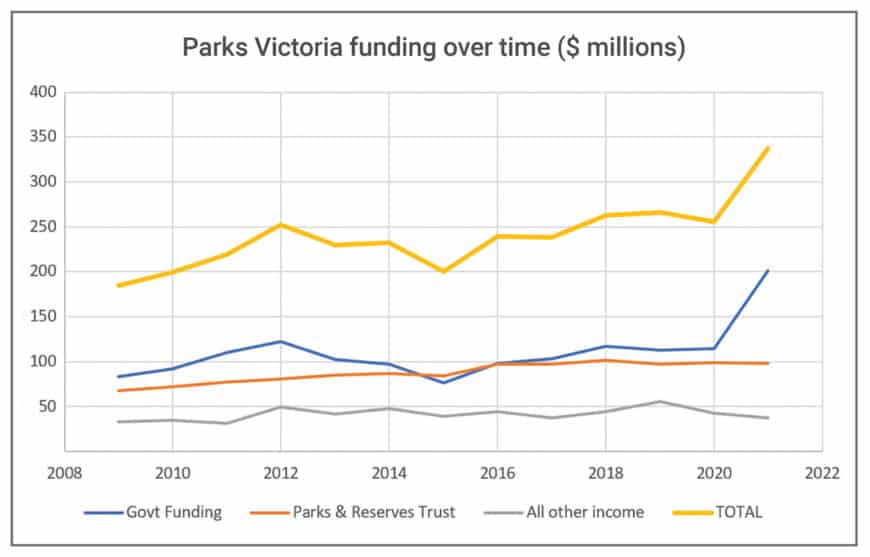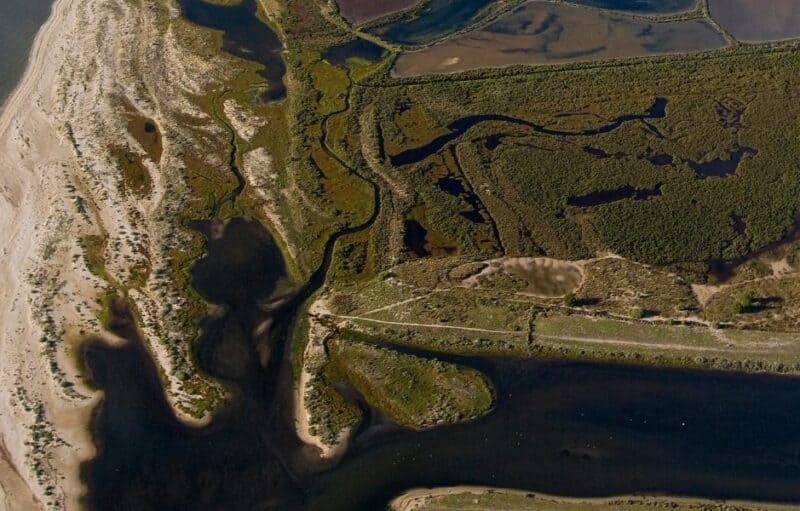PARK WATCH Article June 2022 |
The 2022 state budget does not meet nature’s needs, writes Executive Director Matt Ruchel.
Australians support better funding and management of prime protected areas and national parks, and two recent Victorian Parliamentary Inquiries also recommended significant increases in funding for parks.
A recent national poll by the National Parks Australia Council, of which VNPA is a member, found that 85 per cent of Australians support an increase in government funding for national parks management, and a similar number (83 per cent) support an increase in government funding for staff and rangers for national parks management.
It’s not one-eyed either. Across the political spectrum, support is high for an increase in funding for national park management, with support from nine in ten Labor (92 per cent) and Greens (91 per cent) voters, four out of five (78 per cent) Coalition voters, and 78 per cent for ‘other’ voters.
Across the board, 93 per cent of those said a policy for better funding for the management of national parks and conservation would make them more likely to vote for a political party at the next federal or state election.
For more detail on this polling, read ‘Majority rules‘ in Park Watch March 2022.
Parks Victoria’s total funding in 2020-2021 was $337 million, significantly up from $256 million in 2019-2020 (up $81 million), a 32 per cent increase overall. This was largely from government grants, which according to the Parks Victoria Annual Report were:
“…$35.4 million higher than budgeted. This additional income primarily relates to funding received in 2020–21 to deliver programs over the next few years to assist Victoria to recover and revitalise its tourism economy from the combined effects of bushfires and the COVID pandemic.”
Core conservation estate funding (for parks management and staffing) increased by $21 million in 2020-2021, but there were also significant additional grants, including over $40 million in special grant projects. What is unclear in the Parks Victoria Annual Report, and the state budget generally, is that it is very hard to tell the difference between investment in infrastructure projects and what is spent on ecological programs. While the two can be linked, it is not always the case that the former benefits the latter.
The $23 million Wilsons Prom Revitalisation project, for example, was welcomed by the VNPA (read ‘The Prom as sanctuary‘ in Park Watch December 2019). This program includes the installation of a ten-kilometre exclusion fence at the Prom will support efforts to turn the national park into a 50,000-hectare sanctuary, keeping destructive species out of the park, and supporting the recovery and re-establishment of native animals, plants and habitats. This is obviously an ecological program, but the funding also includes a lot to spend on infrastructure projects, including:
- an upgrade of the Tidal River Visitor and Education Centre
- improved carpark and traffic management
- three accommodation units outside the northern park boundary
- two accommodation units at Tidal River in existing accommodation areas
- a new Telegraph Saddle trail to connect Tidal River and Mount Oberon
While the state budget’s direct government funding for parks went up substantially, much of it was for infrastructure.
However, the contribution from the other key plank of Parks Victoria funding, the Parks and Reserves Trust, went down slightly. The Parks and Reserves Trust is funded by a parks charge included on the water, sewerage and drainage bills of residential and commercial properties since 1958. The Department of Environment, Land, Water and Planning (DELWP) distributes it to Parks Victoria and other entities such as Melbourne’s zoos, the Royal Botanic Gardens and the Shrine of Remembrance for the management and maintenance of metropolitan parks, gardens, trails and waterways. While a very important source of revenue, it has issues.
This funding is tied largely to the management of parks in and around metropolitan Melbourne. While it is a significant amount, roughly 30-40 per cent of Parks Victoria’s total funding, it can only be spent on a small proportion of the parks estate (less than 1 per cent of land area). The second issue is the levy is only collected on some Melbourne residents, those within the old Melbourne Metropolitan Board of Works (MMBW) boundaries, which has been abolished for 30 years, and the city has now well outgrown.
So how much funding do parks really need?
You might as well ask how long is a piece of string… the answer is probably as much as they can get.
As we live in the most cleared state in Australia, even our largest parks still suffer from fragmentation impacts and an onslaught of feral species. This is getting worse under climate change. Parks need active management – control of the many pest plants and animals, managing visitor impacts, habitat restoration, fire management, not to mention ecological monitoring and managing threatened species with specific needs.
One way of calculating it is a ‘bottom up’ approach, identifying the values and the threats, prioritising management actions, and then costing them. This would be an ideal approach, and Parks Victoria has done some of this work through its Conservation Action Plans (CAPs) which cover eighteen parks landscapes across the state. The costing of actions identified in the plans has yet to be done, but would be an important exercise.
Another option is to look at contribution and role in the life of the state that parks play, and from that, determine a fair proportion. National parks and other conservation reserves contribute more than $2.5 billion to the state economy through visitation and avoided health costs of at least $200 million per year, not to mention many hundreds of millions in ecological services such as water quality, water production, pollination and more. In addition, they protect whole habitats for many native species.
Total Victorian state expenditure is expected to be $90 billion in 2020-21. On that basis, Parks Victoria receives about 0.37 per cent of the annual state budget, to manage 18 per cent of our land areas and 5 per cent of our marine waters. We have campaigned for Parks Victoria to get at least 1 per cent of state expenditure – a seemingly small percentage but which would more than double its current budget. However, others have now gone further in their recommendations.
The recent Victorian Parliamentary Inquiry into Ecosystem Decline recommended Parks Victoria funding to be increased to 1 per cent of Gross State Product (GSP). GSP is a measurement of a state’s output; it is the sum of value added from all industries in the state. GSP is the state counterpart to the nation’s Gross Domestic Product (GDP). Victorian Gross State Product was forecast to be about $445 billion in 2020-2021, of which one per cent would be roughly $4.5 billion annually.
The Legislative Council Environment and Planning Committee noted:
“…widespread concerns regarding the ability of Parks Victoria and other public land managers to undertake active and adaptive management of the State’s parks and reserves within current funding frameworks. While funding allocations have increased from previous years, there are significant challenges in managing the parks estate, including in relation to the rapid effects of climate change. It is imperative that these protected areas are effectively managed in order to conserve and restore Victoria’s precious biodiversity. In light of the need for transformative change to reverse the current trajectory of ecosystem decline, the Committee considers that further increased funding for Parks Victoria to undertake active and adaptive land management in the State’s parks and reserves is crucial”.
Recommendation 37: That the Victorian Government increase funding for Parks Victoria to undertake action and adaptive land management in the State’s parks and reserves, and consider increasing this funding to 1% of Gross State Product.
We would certainly expect some high-quality park management with that sort of money, but it does illustrate the quantum of the challenge if we are to keep our state healthy after a couple of hundred years of decline, and the impact of climate change on natural systems. Let’s hope the Victorian Government is listening – its response to the report is due in May (not yet released at the time of writing).
A different Parliamentary Inquiry into Environmental Infrastructure for Growing Populations, released on the 9 February this year, also raised the funding issue. The Legislative Assembly Environment and Planning Committee found that “…there is a strong case for a significant and on-going funding increase in real terms, for Parks Victoria”. While this Committee was more focused on “asset maintenance” and urban growth areas, the recommendation is nevertheless important.
Finding 38: The Committee considers that there is a strong case for a significant and ongoing funding increase, in real terms, for Parks Victoria. This increase should be sufficient to enable Parks Victoria to meet the growing costs of its asset maintenance and recurrent programs in Melbourne’s growth area local government areas.
Recommendation 40: That the Victorian Government review the provision of funding to Parks Victoria to meet the growing costs of its asset maintenance and recurrent programs.
Budget discussions and economic metrics focus on health, education, transport and law and order. The environment and our care for it barely get a mention these days. But using a simple economic metric such as the proportion of state expenditure can have real value. Similar metrics are used often in the national context to talk about defence spending or foreign aid – in this case, it would be in defence of our unique natural areas and in aid of our threatened species.
We’ll keep advocating for our national parks and protected areas get the funding that is their fair share.
Did you like reading this article? You can read the latest full edition of Park Watch magazine online.
Want to be kept up to date about this and other nature issues in Victoria? Subscribe to our email updates.
You can also receive our print magazine Park Watch four times a year by becoming a member. Find out more.

